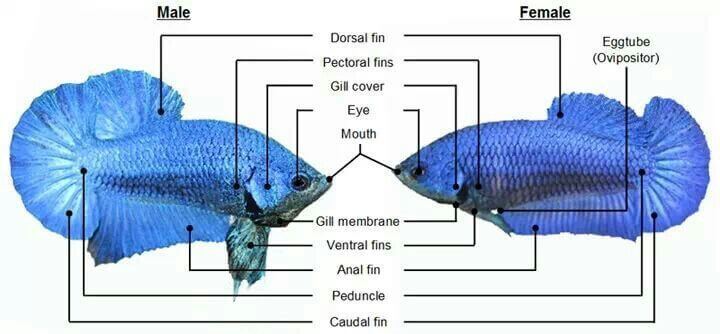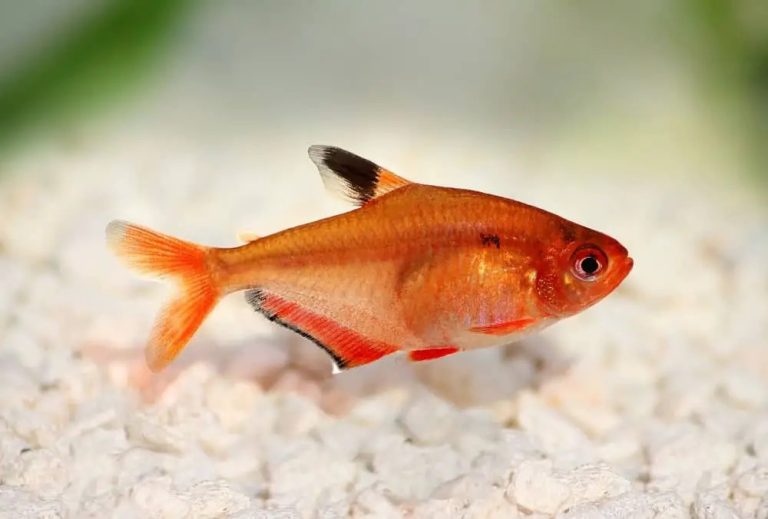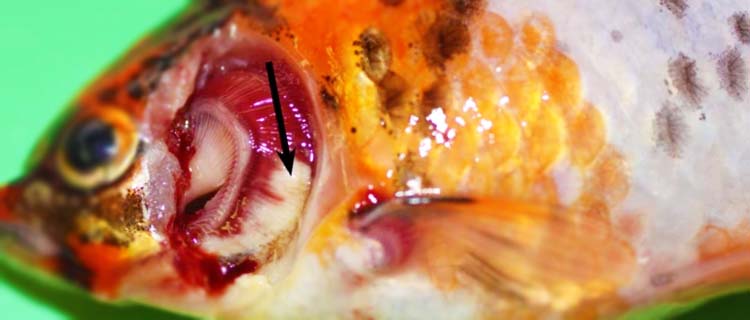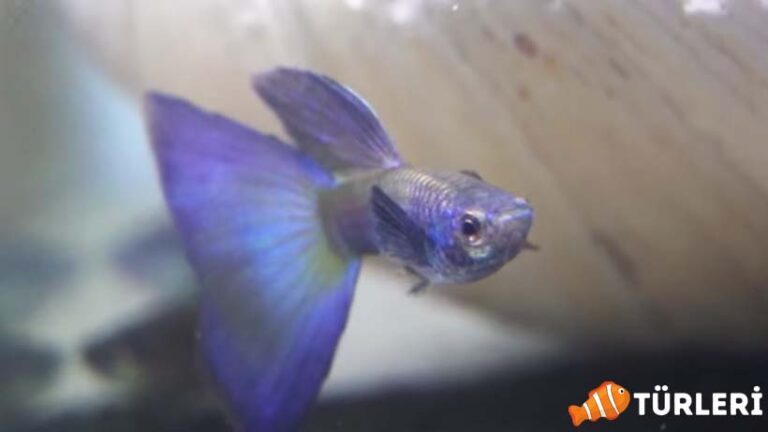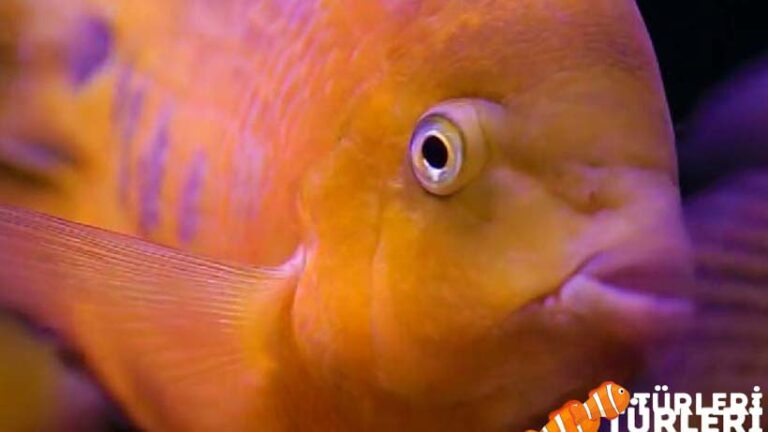Betta Fish Types: 27 Betta Types by Color, Tail, and Patterns
Choosing a betta fish that matches your personality can be exhausting due to their endless variety of colors and patterns. Before setting up a betta aquarium, it’s crucial to have comprehensive knowledge about them.
Betta fish (betta splendens) rank amongst the most popular freshwater fish for aquariums. Their variety in colors and shapes makes them a beloved species. They possess unique characteristics that distinguish them from other aquarium fish.
Because there are so many types, distinguishing the best ones usually depends on their tail shape, patterns, and colors.
Someone new to the aquarium hobby might be surprised at a betta’s aggressive behavior. However, when fed the right diet and kept in a properly set up environment, they don’t usually pose any problems.
It should be noted that bettas cannot coexist with many other fish species in the same tank. Either dedicate a tank solely to them or get a large aquarium and introduce species that are compatible with bettas. In this article, we’ll help you find the betta that reflects you best. Let’s begin!
Betta Fish Types

Betta fish, also known as Siamese fighting fish, are usually the first choice for beginners in the aquarium hobby. They’re affordable compared to many other fish, and their care is relatively simple. Both these factors, combined with their stunning appearance, make them a sought-after species.
If you’re looking for a fish that can bond with you, the betta fish might be your first choice. These fish can display unusual behaviors. If you see your fish blowing bubbles on the water’s surface, don’t be alarmed. It’s a behavior typical of bettas.
Bettas have a respiratory organ called a “labyrinth.” This allows them to breathe free oxygen from the air when there isn’t enough in the water. As long as their skin stays moist, they can survive.
You can categorize bettas based on the size, pattern, shape, and colors of their tails.
Their tails can vary widely, from long and flowing to short and straight. Their body shapes can also vary considerably.
But, of course, their most distinctive features are their vibrant colors. Combine these characteristics, and you have hundreds of betta types. Each betta type is unique, and no two are precisely alike. Now, let’s touch upon some of the most beautiful betta fish varieties.
Types of Betta Fish by Color
While many bettas are monochromatic, some can display multiple colors. A single betta can possess 2-3 different colors. Pigment cells on their skin determine their actual color.
If your betta’s color is changing, it could be due to three reasons:
- Your fish might have the marble gene.
- Your aquarium water might be colder than ideal.
- Sadly, your fish might be ill.
Blue Betta Fish

Blue betta types are probably the most common. However, there are many shades of blue. The most known varieties are Steel Blue, Turquoise Blue, and Royal Blue. Among blue bettas, my personal favorite is the Royal Blue Betta.
Red Betta Fish

If you want a dominant betta, a red one might be your color. Red bettas are known for their dominance. Swimming in the aquarium, their red hue is a real eye-catcher. This color can be found in most betta types.
If your betta isn’t vivid red (if it’s pale), you might want to check your aquarium’s water quality. The pH, oxygen levels, or water temperature might not be optimal.
The vivacity of the color is not just about these factors. The feed you provide can also affect it.
Black Orchid Betta
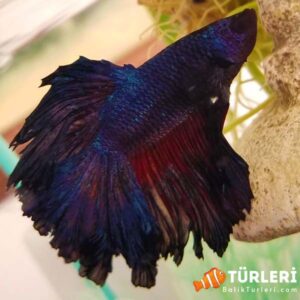
The Black Orchid Betta can be categorized into three types: Black Lace, Metallic, and Melano. Bettas are generally known for their vibrant and beautiful colors. Even with black, they can be appealing.
If you’re after a graceful fish, the black orchid betta can provide what you seek. You can spot blue or purple hues on its body and tail. Among the popular types in this color is the crown tail black orchid betta.
Pink Betta Fish

Pink is one of the colors that hasn’t been successfully bred in bettas. However, lavender bettas can exhibit hints of pink. Fancy bettas can also have parts displaying pink shades.
Efforts are still being made to produce a pink betta. Until then, you can opt for the mentioned types like Fancy and Lavender.
Yellow Betta Fish
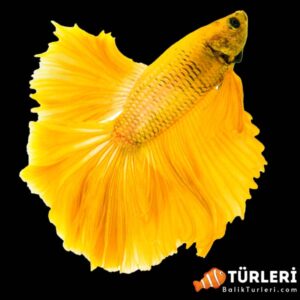
Yellow is as common as blue in betta fish. This fish usually showcases a rich yellow hue, especially along its fins and tail.
Yellow isn’t found in wild bettas due to the presence of the red color in their genes. Yellow bettas are a result of domestication. Domesticated bettas lack the red gene, leading to the emergence of yellow.
You can find this type in various shades, from bright, solid yellow to soft, gradient hues.
Purple Betta Fish

Finding a purple betta is akin to searching for a needle in a haystack. Genuine purple bettas are extremely rare. While you can find many photos online, finding one in real life is harder.
To date, a flawless, pure purple betta was bred only by “Chiawcharn Chaisaeng”. Mr. Chaisaeng keeps the method of breeding this fish a secret at his farm named Minburi Betta in Bangkok.
Even if it’s not pure purple, there are a few varieties where you can spot this color mixed in.
White Betta Fish

While the white betta fish may seem plain compared to the splendid other colors, it’s not just the color but also the tail types that make betta fish special. With the right fin type, there are bettas that can look fantastic in white. A simple aquarium with a dark background can eliminate any prejudice you have against white bettas.
Green Betta Fish
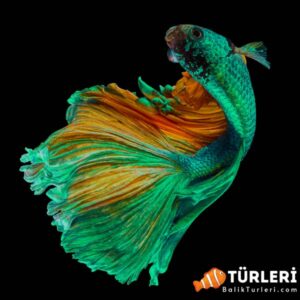
It’s hard to find a completely green betta fish. They are often seen with a metallic color close to turquoise. If you look closely at the green bettas, you can see a combination of dark and light tones. If you shine a light on it, you can examine the sparkling details of its colors. If you can see pure dark green with the naked eye, your fish is one of the rare bettas.
Betta Fish by Tail Types
Betta fish types are usually classified according to tail shape. Undoubtedly, the tail plays a major role in making bettas so attractive. Although there are dozens of types, some of them have been forgotten as bettas have become popular in the aquarium hobby. Of course, the fact that the new variations have more aesthetic tail shapes has a major influence on this. They come in many tail shapes and colors, now you need to find out which one attracts you the most.
Veil Tail Betta
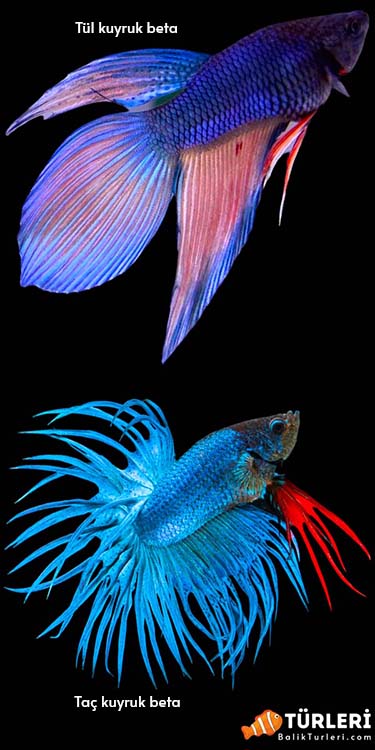
Veil tail betta is the most commonly known species among hobbyists in many countries, including Turkey. What really defines a betta fish is this tail shape. Due to their popularity, they are more preferred in aquariums. If you want your veil tail betta to reproduce, the fish you will likely get will probably have the same tail shape. This is because this tail shape is known for its genetic dominance. However, they are among the easiest species to breed. The male of this variation has a long tail that flows downwards. They come in many color variations and their general appearance is quite striking. Their tails and fins thin towards the end, giving them the veil-like drooping shape from which they get their name. Male bettas have longer tails, while females have relatively shorter tails.
Crown Tail Betta
The crown tail betta is one of the younger variations. It was first bred by Ahmad Yusuf in Indonesia about 25 years ago. Crown tail betta variations have differentiated over time and have been grouped. Those with longer tails can be much more aggressive. They look very beautiful when all their fins are tense. The spine of the fin and tail becomes longer compared to the membrane, giving it a fringed structure.
Comb Tail Betta
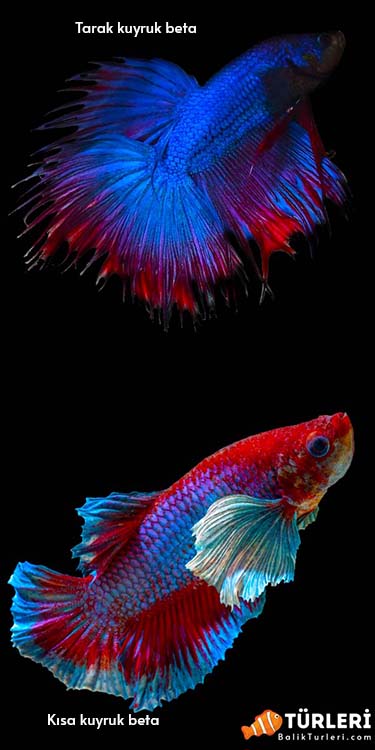
The comb tail betta has a long tail like the crown tail, but not as long. The comb tail has a serrated edge on the fins and tail. The most distinctive difference between them and crown tails is the tail spine. In comb tails, this structure is shorter. Due to their similarity to crown tails, they are among the most difficult betta fish species to classify.
To easily differentiate them from crown tails, you can consider the following:
The divisions in the spines should be apart enough to be seen from a distance.
These divisions should be about a third of the length from where they start to the end. In crown tails, these separations are much more pronounced and should be differentiated by looking at this.
Short Tail Betta
Short tail betta fish, compared to other species, have a more rounded and short tail. They are also called Plakat bettas. This name was given to them in Thai. They are almost on the edge of being betta because they do not have the magnificent long tail typical of bettas. This betta species is considered a traditional species in its habitat, one that has not undergone aquarium evolution. Possibly because of this, they are much more aggressive and energetic than the others. Although their body structures have not evolved, there are very nice and magnificent short tails.
Halfmoon Betta

Halfmoon bettas are actually a type of delta tail. They are named for their tails that resemble a half-moon. They have been separately classified from deltas because their tail sizes exceed 180 degrees. This feature is the most prominent that makes them magnificent.
“This species cannot be found in its natural habitat. This is because they were bred by experts for display in shows. They were first bred in the 1980s. After that, they spread to Europe and the rest of the world.
The quality of this species is understood by several characteristics, such as:
- The width of the tail,
- Equal length of the tail fins,
- The shape of the tail resembling a semi-circle,
- The proportional lengths of the fins to the tail,
- When all fins are stretched, they align with the tail.
Double Tail Betta:
The double tail betta was produced in the early 1960s by a betta enthusiast from India. In fact, the double tail is an evolved fish that is not seen in its habitat. Its name comes from having a dorsal fin similar in length to its ventral fin, and additionally, two tail lobes.
The dorsal fin of this betta is more built than other species. This variety is rare among betta fish species. For this fish to breed successfully, it must not be paired with its kind but with delta tails. This is because the offspring of two double tails bred together often have a high rate of deformities.
Dumbo Betta (Elephant Ear Betta):

Dumbo Bettas, also known as Elephant Ear Bettas, are truly magnificent. They are named for their very large pectoral fins.
These fins can either be the same color as the fish’s body or a shade darker. Actually, this fish doesn’t fit the color section or the tail section. What makes it unique compared to other bettas are its pectoral fins.
Elephant Ear Bettas are usually brightly colored. The most common colors you can find in aquariums are bright blue, red, yellow, and turquoise. However, in their natural environment, they also have dull colors like green and brown.
Delta Tail Betta:
Delta tail betta has different classes within itself. The angle of the space between its flared tail determines its class. It gets its name “Delta” because when its tail is fully spread, it resembles the Greek letter ‘D’ (∆).
If the angle is between 50-70 degrees, it is called a Delta Tail. If it’s between 70-120 degrees, it’s Super Delta Tail, and between 120-160 degrees, it’s Ultra Delta Tail.
Different Tail Types
Rose Tail Betta (Rose Tail): The Rose Tail Betta is a variety of the Halfmoon Betta. What sets this fish apart is its more branched tail fin, which gives it the appearance of a rose. However, if the tail is excessively branched or frilled, it is termed as a Veil tail.
Feather Tail Betta (Feather Tail): The Feather Tail Betta is considered a type that shouldn’t be bred. The reason being, it mutates into poor fins and a significant proportion of weak fish. This species, evolved from Halfmoon Bettas, is more inactive compared to others.
Fan Tail Betta (Fan Tail): The Fan Tail differs from the sharp-edged deltas with its slightly rounder tail. They don’t have sharp tails like Deltas. This is due to the top and bottom fins being shorter compared to the middle ones.
Spade Tail Betta (Spade Tail): As the name suggests, Spade Tail Bettas resemble the shape of a spade with their sharp tail tips. They are a rare type of Betta. Although they look beautiful, they are somewhat overshadowed by other Betta types.
Over Halfmoon Betta (Over Halfmoon): Over Halfmoon Bettas are a variety of Halfmoon Bettas. What differentiates them is when they spread their tails, they achieve an angle of about 300 degrees.
Halfsun Tail Betta (Halfsun Tail): This type of Betta has tails with a 180-degree angle like the Halfmoon Bettas. But additionally, they also have a fringed shape like the Crown Tail Bettas. This rare type is produced by breeding Halfmoon and Crown Tail Bettas.
Round Tail Betta (Round Tail): The Round Tail Betta is one of the popular Betta types you can find. Their tails are similar to the Delta type but without the straight edges. This results in the tails looking round, like a half-circle. Despite having a broad tail, they have a less flamboyant tail. Their fins and tail don’t grow much longer.
Betta Fish by Patterns
Have you come this far and still can’t decide on the type? Don’t worry, the patterns will help you choose your Betta fish.
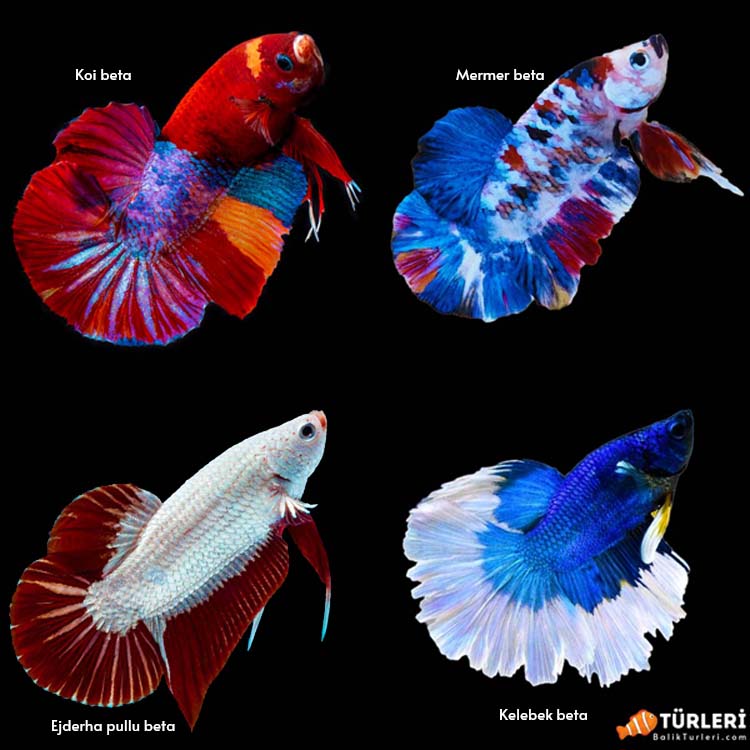
Patterns can enhance colors, making them appear much more attractive. Some patterns have been created over many years by selectively breeding specific strains.
Dragon Scale Betta (Dragon Scale Betta): The Dragon Scale Betta is a relatively new type produced after specific breeding trials. Its name comes from its scales that resemble those of a dragon or lizard. This type, along with its metallic, vibrant colors, is sought after among Betta enthusiasts.
Butterfly Betta (Butterfly Betta): This type exhibits a consistent color extending from the fins to the tail. Often, this color appears white or transparent. Cultivating a pure butterfly Betta is not a straightforward breeding process. For it to be deemed a genuine butterfly Betta, this pattern should start from the middle of the tail and have an even width towards the edge.
Marble Betta Fish (Marble Beta): The Marble Betta fish has a multitude of color combinations, which makes it a popular type. The fins display a pattern resembling marble. Another intriguing trait of this type is its occasional ability to change colors. You might notice a change in your fish’s color in as short as a week. However, this impressive ability fades as the fish gets older. Interestingly, the breeding of this fish is as peculiar as the fish itself. Marble Beta fish were bred in the 1970s by Orville Gulley in prison. He initially aimed to produce a black butterfly type, but ended up creating this variety. The original colors during its first cultivation were black and white, but today, breeding is possible in all colors.
Koi Betta Fish (Koi Betta): Koi Bettas were named because of their resemblance to Japanese Koi fish. They aren’t directly related to Kois, but were bred to look similar. They are a variation achieved from breeding Marble Bettas. They come in many colors, patterns, and variations and do not belong to a particular color scale. Breeders cultivated them specifically for aquariums, so you won’t find Koi Bettas in the wild.
Which Fish Can Betta Live With?
Bettas are extremely aggressive and territorial towards their own kind. They can also be aggressive or be targeted by other species. Hence, if you’re looking to add fish to a Betta aquarium, you must consider the species and tank size.
The following aquarium fish are suitable companions for Bettas:
- Otocat fish
- Zebra danio
- Some gourami types
- Rasbora
- Loach
- Corydoras (catfish)
- Dwarf stingray
To house Bettas with other fish, ensure the tank is adequately sized. The chosen fish should be non-predatory, small in size, and preferably swim at the bottom or mid-bottom levels.
Differences Between Male and Female Bettas
Let’s briefly touch upon the gender distinction in Bettas. Males are more magnificent compared to females. They especially have notably wide and large dorsal fins. Here’s a list to assist in gender differentiation:
- Female Bettas appear plumper, while male Bettas have longer, slender bodies.
- Male Bettas create bubbles at the surface of the aquarium, especially during breeding times.
- The fins of male Bettas are longer compared to females, which makes them appear curled. This fin length is essential for gender identification in female Bettas.
- If the fish isn’t stressed or ill, male Bettas generally have brighter colors.
- Females have a small white protrusion behind their ventral fin.
By placing a small mirror on the aquarium glass, you can also get an idea about its gender. If the fish acts very aggressively towards its reflection, it’s probably male. If it attacks a few times and then becomes indifferent, it’s likely female.
If you own a Betta fish, which type is your favorite? You can mention this in the comments section below and feel free to ask any questions you might have.
There’s no end to what can be said about the Betta fish. Even though we couldn’t touch upon all the color, pattern, and tail types, we discussed many popular and available types. Whichever color or type you choose, the Betta fish (also known as the Siamese fighting fish) is an incredibly special and unique species.
Over time, experts have bred new types and continue to do so. There are already hundreds of Betta fish varieties. As with many aquarium fish species, the male Betta fish’s splendor is more beautiful than the female’s.
To keep these fish happy, a 20-liter aquarium will suffice (the larger the aquarium, the better your fish will feel). While Bettas are aggressive and combative and may have more muted colors in their natural habitat, there are varieties that can look magnificent in your aquarium.
The most important thing to be cautious about is not to keep Bettas with incompatible fish.
FAQ
Which Fish Can Live with Betta Fish?
The types of fish that can coexist with Bettas include otocats, zebra danios, certain gourami species, rasboras, loaches, and corydoras (also known as cleaner fish). However, in order to keep other fish alongside bettas, it’s essential to ensure the aquarium has adequate space.



